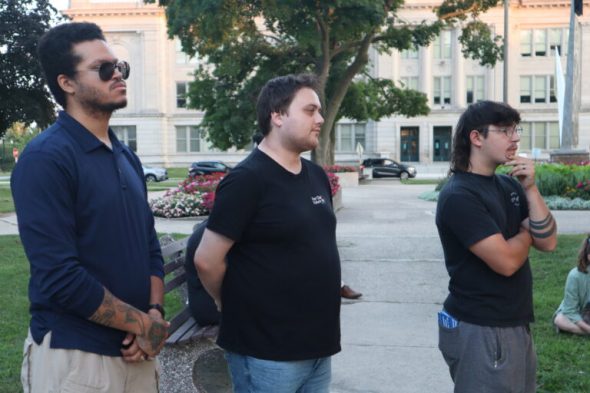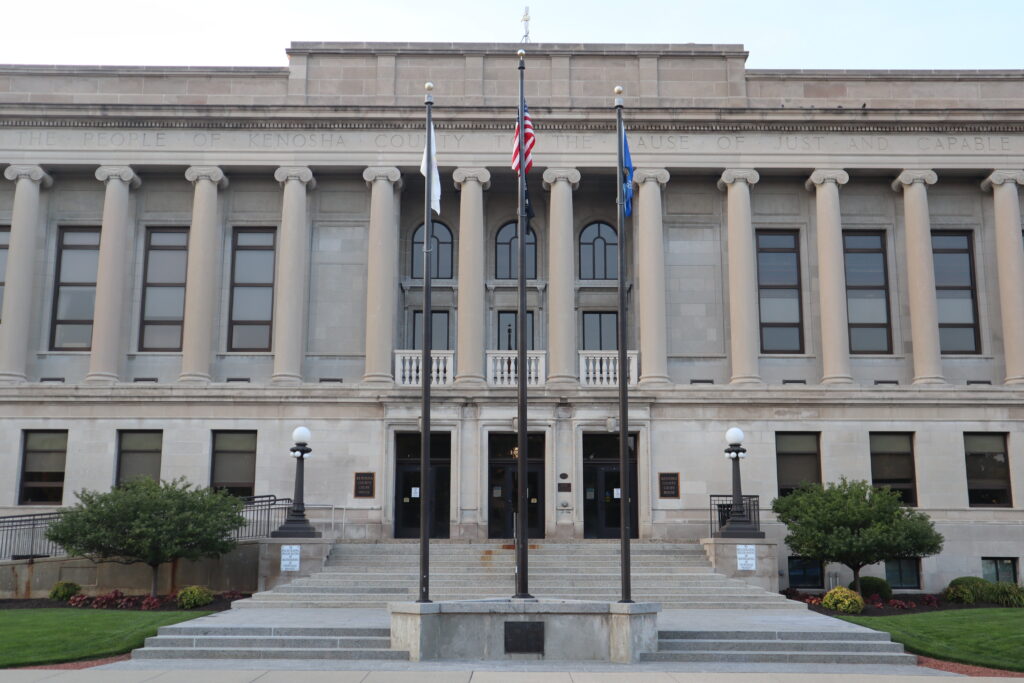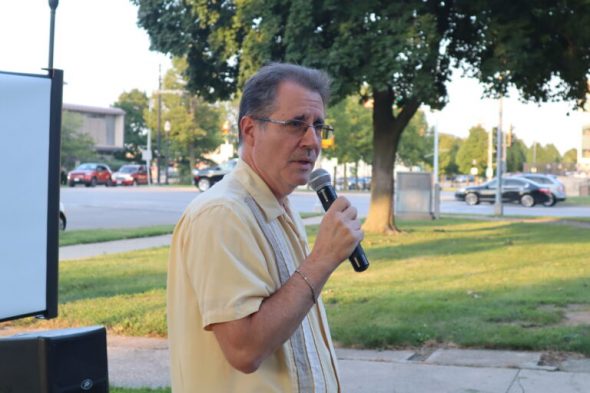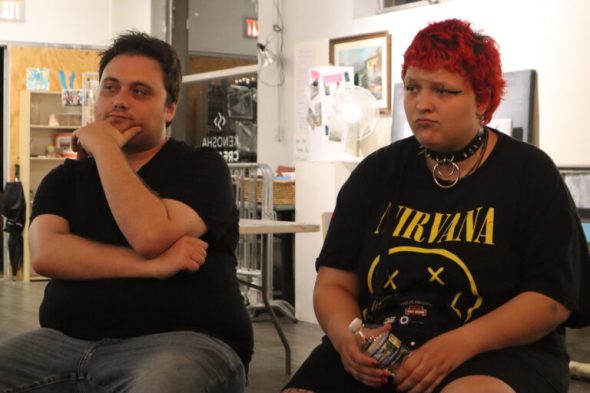Kenosha Event Revisits 2020 Unrest
Questions, trauma linger. And just how quick was Evers' response?
Two years after the unrest that followed the shooting of Jacob Blake, a sense of mournful angst loomed thick in the Kenosha’s Civic Park Wednesday evening as a modest gathering of community members assembled to unpack those few chaotic nights. The evening was one of reflection, but also refusal to allow Kenosha’s uprising to be exploited and forgotten.
Other than those who had gathered for the event, Civic Park was empty of people. Organized by Black Leaders Organizing Communities (BLOC), For Our Future Wisconsin, and Leaders of Kenosha (LOK), the event revisited the unrest on the ground where it occurred, on a night when Civic Park was filled with crowds of protesters confronted by National Guard soldiers, riot police, and the federal agencies assisting them.

Kyle Johnson of BLOC (left) and Kyle Flood of For Our Future Wisconsin (center) stand with other community members in Civic Park, two years after the Kenosha uprising. Photo by Isiah Holmes/Wisconsin Examiner.
A cacophony of screaming and the explosions of firework mortars blanketed the park that August night. Protesters were met with air-burst flash bangs, rubber bullets or pepper balls every time the police riot line was approached. Sound cannons and police sirens drowned out other noise. An acrid paint-like odor from the gas filled the air, followed by the sounds of gagging, coughing and crying. People called for medics or tried with varying success to move others to safety. The regular, yet unpredictable ricochet of rubber bullets left some afraid to move — yet, staying in one place also seemed unwise. Fires burned around and the late evening hours offered no signs of de-escalation.
That was the day after Blake was shot, and the day before armed militia groups descended on Kenosha. But while these evenings caught international attention, they were not the first days of protest.
Kenosha’s protests began immediately after the murder of George Floyd in May 2020 and persisted throughout that summer. The idea that they exploded suddenly is a misconception resented by many who gathered in the park Wednesday evening.
Kenosha County Supervisor John Franco, one of the evening’s speakers, alluded to Republican campaign messaging that “Gov. Tony Evers let Kenosha burn” and poked holes in that narrative. The claim is “a politically motivated talking point exploiting what happened in the summer of 2020 in order to undermine the campaign of Gov. Evers,” Franco said.
Investigations by the Wisconsin Examiner also found that local authorities told federal U.S. Marshals that the protests “had not reached the point of needing law enforcement response outside of local Kenosha County law enforcement agencies and surrounding counties.” The U.S. Marshal communication confirmed that “in the early morning hours of Aug. 24, the protests devolved into a riot situation and the Kenosha Police Department requested our assistance.”
Evers also requested the assistance of the Federal Bureau of Investigation (FBI), and there was a National Guard “quick strike force that arrived within 12 hours,” explained Franco. With only one National Guard battalion, about 500 soldiers, trained as military police for riot control missions, more troops couldn’t be requested, he said. Those facts haven’t prevented the Republican candidate for governor, Tim Michels, and other GOP figures from blaming Evers.
Other speakers Wednesday evening included Rep. David Bowen (D-Milwaukee), who witnessed many of the events in Kenosha, as well as Jacob Blake Sr., along with members of BLOC, LOK, and For Our Future.
Hannah Gittings, whose partner, Anthony Huber, was killed by then-17-year old Kyle Rittenhouse, was also in attendance Wednesday evening. Huber was filmed hitting Rittenhouse with a skateboard shortly after the teen shot and killed Joseph Rosenbaum.
The apparently easy-going closeness law enforcement personnel had with the armed militias haunts residents. Police communications show that the police saw the militias, rallied by former Kenosha alder Kevin Mathewson on the “Kenosha Guard” Facebook page, as friendly. Local authorities also were aware of reports of militia slashing the car tires of protesters half an hour before the Rittenhouse shooting. Rittenhouse was filmed in a group that was offered water and thanks by police in an armored vehicle.
Like many attached to the events of Aug. 25, 2020, Gittings has faced harassment and death threats by supporters of Rittenhouse. Gittings recalled how police pushed protesters down the street that night, and feels it’s no coincidence that, “they pushed us right into the arms of the militia.” Many others who were in the crowd that night also have said they felt police herded protesters toward the militia.
Struggling to hold back tears, Gittings recalled Huber’s kind and helpful nature. “Anthony loved this city,” she said. “He really loved this city.”
Lingering traumas, questions and motivation
The Wisconsin Examiner was invited to join a private community dialogue after the public Civic Park event. There, participants shared their sense that national and international media along with politicians have all exploited Kenosha’s trauma.
“I feel like the media was only here to get their good shots of the buildings burning and people protesting, and then they got out,” said Devynn Johnson, a volunteer at the Grace Welcome Center food pantry who also helped organize medic teams during the unrest. “Because they wanted to spin their image of Kenosha to make people think it was something else than it really was.”
The nights of unrest in late August were sensationalized, said Kyle Johnson, a member of Kenosha BLOC. He contrasted the attention surrounding those events with what happened after the Blake shooting was ruled justified in January 2021 and after the acquittal of Rittenhouse in November 2021: “Nothing,” Johnson said.
“We had some healing, we had some great conversations,” he continued. “Not a building was burned, not a window was smashed. And, lo and behold, we didn’t see Fox News, we didn’t see CNN, we didn’t see MSNBC, with their cameras asking, ‘Hey how did you guys get this done? How did you make sure that what happened in August of 2020 didn’t happen during the trial?’”
For Kenosha residents, a broader historical context also got lost in the noise. Dayvin Hallmon, who served on Kenosha’s county board for 10 years, warned colleagues for years that ignoring problems with the police and the needs of minority communities would one day trigger unrest. Hallmon “knew that Kenosha was the perfect recipe for this to happen,” said Devynn Johnson. “And we all kind of felt like that, that Kenosha was being built up to this.”
Sensationalization and over-simplification of the narrative around Kenosha has clouded how people perceive the community. Kyle Johnson said he’s met numerous conservatives in the community who, contrary to popular assumption, don’t agree with the outcome of the Rittenhouse trial.

An example of a challenge coin distributed within the Kenosha Police Department following the unrest in August, 2020. Photo from the Kenosha Police Department.
“For the most part, a lot of people are coming together to figure out how we can prevent the taco spot from burning down ever again, or the theater,” Kyle Johnson said, referring to buildings that had been torched in the unrest. “Those are the conversations we are having here.”
Many wonder who caused most of the destruction, noted Dionisse Molila, a Kenosha resident of 15 years who works at the Grace Welcome Center. Molila and others in the conversation said they didn’t recognize local residents among the people destroying property.
People who traveled from Washington, Oregon, and California were among those charged in the unrest. Three men charged with arson last year and subsequently convicted traveled from Minnesota. Many of those arrested, however, were people from the surrounding area. They included people ticketed for being out past curfew, as well as activists seemingly targeted for arrest.
Stranger things, often scarcely reported, occurred during and after the nights of unrest. Residents talked of seeing large pallets of bricks being mysteriously left around town. There were rumors of informants hiding among the protesters and livestreamers. Molila, Flood and others told of one man who seemed particularly “gung-ho” to organize people, recommending they mark their clothing with tape. Activists from other states later told them to not trust the man, and that he’d been linked to several arrests of protesters. Everyone in the room felt they were also placed under surveillance.
Tanya McLean, executive director of LOK, recalled her phone acting up — forced reboots, text messages that didn’t reach their destination, and echoes, static or clicking during calls. Kyle Johnson pointed at Flood — “I still can’t receive his texts,” he said. “It was just a really scary time,” said McLean.
Devynn Johnson and Flood also recalled a friend who was arrested for curfew being monitored by undercover police. “When she got back out of jail there was an unmarked squad just parked there,” said Flood. “And just stayed there. Also her door was unlocked. … She was very scared.” At night, Johnson and Flood heard footsteps in their apartment’s hallway, creeping around their door. “There were nights when we couldn’t sleep at our house and we stayed with friends because we were so scared, because our old house was easy to break into,” Johnson said. Many protesters in Milwaukee had similar experiences. “The unmarked [police cars] are more concerning,” said Flood. “It’s when we can’t tell who they are, it gets weird.”
Jacob Blake Sr., sitting in the group, said he had the same experiences of being monitored. Blake told Wisconsin Examiner that during the Trump administration, the FBI appeared to not take seriously the death threats he received. Yet, he remains suspicious of the FBI under President Joe Biden. Blake was also arrested this past July, during protests in Akron, Ohio following the killing of Jayland Walker. The 25-year-old was shot over 50 times as he fled officers. “I’ve been to the White House three times,” said Blake. “If you’re not changing laws, then you’re not changing the circumstances.”
For the Kenosha residents who had gathered this evening to return to those nights in 2020, other questions continue to linger. They wonder which officer gave the order to push protesters down the street towards the armed groups. “I want to know why police were handing water bottles to militia, but telling protesters to go home,” said Devynn Johnson. Kyle Johnson wonders how much money was actually spent by law enforcement. “We have a lot of rhetoric about the investigations into the 2020 election, why are there not investigations into the local government’s response to this?” he asked. “How much money could we have invested in our communities? Easily millions.”
Memories are haunting. During the unrest, Devynn Johnson was organizing medic teams when he tended to someone whose eye had been shot out by a rubber bullet. “I held their eye in my hand,” said Johnson, now crying. “I want to know why the police think it’s okay to use those weapons that do that to people. I held someone’s eye in my hand, and I want to know why they think it’s OK.”
Flood offered a final question, directed at the Kenosha history museum. “Why isn’t there a single effort going into preserving the history of what happened,” he asked. “Why are they trying to erase that this even happened?”
Moving forward
Through everything that’s happened, Kenosha’s activist community has continued to evolve. Before 2020, McLean and others told Wisconsin Examiner, the area didn’t have much of a grassroots network. Since then, groups have come into being, condensed and reformed. Flood, who’s been a local activist for a decade, said participation ebbs and flows.
“I think there appears to be less energy than there was in 2020 because there’s fewer people coming out and doing stuff,” said Flood. “I think that’s a big mix of trauma, and the energy’s not there because people are tired and people are exhausted.” While marches may attract slim numbers from time to time, more people appear to be speaking out at local government meetings, he said. “We’re starting to move into a new phase.”
Michels and other Republican politicians visited Kenosha for the anniversary of the unrest, where Michels received the endorsement of Kenosha’s police union. On the anniversary of Blake’s shooting, he stood with a group of officers including Pablo Torres, who shot two people 10 days apart in 2015, one of them fatally.
Some in the community see the police union as politically powerful with sway over the city’s budget, and they are troubled. Still, grassroots organizations remain steadfast, and now prefer working in small collectives rather than massive groups, or exhausting resources with daily protests. To some, Kenosha has just been seen as a political tool, said Kyle Johnson. But to members of the community, the city is much more.
“The people that actually want to make progress are looking forward,” said Johnson. “We’re talking about what we can do to bring solutions, to make people’s lives better, to heal people, to reimagine how we approach community building.”
Kenosha community members reflect on 2020 unrest was originally published by the Wisconsin Examiner.
More about the Kenosha Unrest
- Kenosha Event Revisits 2020 Unrest - Isiah Holmes - Aug 30th, 2022
- WisGOP Statement on One-Year Anniversary of Kenosha Violence - Republican Party of Wisconsin - Aug 24th, 2021
- One Year After Jacob Blake Shooting Kenosha Seeks Answers - Isiah Holmes and Henry Redman - Aug 23rd, 2021
- Tony Evers Lies on Kenosha Record - Republican Party of Wisconsin - Jun 14th, 2021
- Coins Celebrate Policing of Kenosha Protests - Isiah Holmes and Henry Redman - May 18th, 2021
- Did DA Delay Mensah Decision Due To Kenosha Unrest? - Isiah Holmes - Apr 8th, 2021
- How U.S. Marshals Came to Kenosha - Isiah Holmes - Apr 5th, 2021
- Wisconsin Man Indicted for Injuring Police Officer During Kenosha Riots - U.S. Department of Justice - Jan 27th, 2021
- Prosecutors Want Court to Ban Rittenhouse from Bars - Corrinne Hess - Jan 14th, 2021
- Kenosha DA Won’t Charge Cops in Blake Shooting - Corrinne Hess - Jan 5th, 2021
Read more about Kenosha Unrest here






















